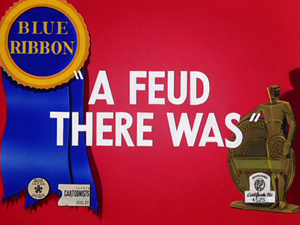A Feud There Was
| A Feud There Was | |
|---|---|
| Production company | Leon Schlesinger Productions |
| Distributor | Warner Bros. Pictures The Vitaphone Corporation |
| Release date | September 24, 1938 |
| Run time | 7:44 |
| Starring | Mel Blanc Tex Avery Billy Bletcher Dave Weber Edna Harris[1] Roy Rogers Son of the Pioneers[2] |
| Producer(s) | Leon Schlesinger |
| Music composition | Carl Stalling |
| Story | Melvin Millar |
| Animation | Sid Sutherland Paul Smith (uncredited)[3] |
| Director(s) | Fred Avery |
| Series navigation | |
| ← Previous | Next → |
| Title card | |

| |
A Feud There Was is the one hundred and fifth Merrie Melodies theatrical short. It was released by Warner Bros. Pictures and The Vitaphone Corporation on September 24, 1938. It was written by Melvin Millar, produced by Leon Schlesinger and directed by Tex Avery.
Elmer Fudd, working as a peacemaker, enters the Ozarks to stop two hillbilly families from waging war at each other.
Detailed summary
| This article or section is a stub. You can help the Looney Tunes Wiki by expanding it. |
Memorable quotes
Cuckoo bird: Watch! That's powerful snorin'. Just like a hurricane... from the motion picture of the same name!
Gray-haired Weaver: The Old Gray Hair ain't what she used to be! (laughs before stopping) Well, it sounded funny in rehearsal, anyway...
Characters
In order of appearance: | ||||||||||
| ||||||||||
Locations
- Earth
- United States
- Ozarks
- Weaver residence
- McCoy residence
- Ozarks
- United States
Objects
- None of importance
Vehicles
- Elmer's scooter
Production
Casting
Elmer's singing voice was provided by Roy Rogers, while additional vocals for the cartoon were done by the Sons of the Pioneers.
Filming
The short was copyrighted in 1938 (MCMXXXVIII).
Music
The music was composed by Carl W. Stalling. The main title and closing themes are a rendition of "Merrily We Roll Along," which are arranged by Stalling. The Blue Ribbon reissues use the 1941-45 variation of the main title theme, while the closing title use the original 1938 theme variation.
Release
Dates are in order of release:
- United States: September 24, 1938; September 11, 1943 (1st Blue Ribbon reissue); September 13, 1952 (2nd reissue)
Behind the scenes
- The MPAA certificate number is 4525.
- This is the first cartoon in which Elmer Fudd is named on-screen, seen inscribed on the scooter he is driving. However, he was previously named in the lobby card for the previous short, The Isle of Pingo Pongo.
- The Weavers and the McCoys are a spoof of the real-life Hatfield and McCoy families, respectively. The short itself is also a parody of the Hatfield-McCoy feud and puts an emphasis on gags related to hillbilly stereotypes.
- This is the first short to use the Blue Ribbon label, a program that would save Warner Bros. plenty of money by re-releasing cartoons for the next 20 years.[4] For the first 13 years, the credits of each re-released cartoon were scrapped, but later, they are kept.
- While a nitrate slide of the original title card is known to exist, it is not a full print and hence the short was restored with only the Blue Ribbon titles. This print was first shown on MeTV via its Saturday Morning Cartoons block and Toon In With Me series, and later released on the Looney Tunes Collector's Choice: Volume 3 Blu-ray set.
Errors
- None (?)
Home availability
- In the United States:
- December 23, 1992: MGM/UA Home Video releases The Golden Age of Looney Tunes: Vol. 3 on LaserDisc.
- March 12, 2024: Warner Archive Collection releases Looney Tunes Collector's Choice: Volume 3 on Blu-ray disc.
References
- ↑ Scott, Keith (September 18, 2022). Cartoon Voices of the Golden Age, Volume 2 (hardcover edition). BearManor Media. ISBN 979-8887710112.
- ↑ Ohmart, Ben (2012). Mel Blanc: The Man of a Thousand Voices. Bearmanor Media. ISBN 978-1593937881.
- ↑ "Paul Smith Reel". Internet Archive (December 20, 2020).
- ↑ J. Hayde, Michael (August 18, 2013). " BLUE RIBBON BLUES ". Michael J. Hayde's BETTER LIVING THROUGH TELEVISION. Retrieved May 1, 2025